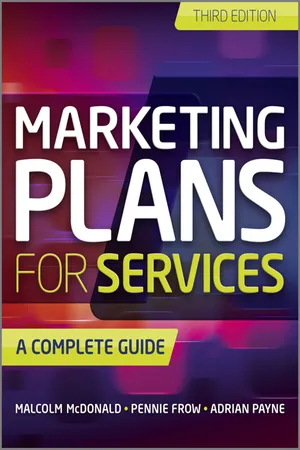Marketing Services
Marketing services refer to the activities and processes involved in promoting, selling, and distributing products or services to consumers. These services can include market research, advertising, public relations, and digital marketing, among others. The goal of marketing services is to attract and retain customers, ultimately driving business growth and profitability.
7 Key excerpts on "Marketing Services"
- eBook - ePub
Marketing Plans for Services
A Complete Guide
- Malcolm McDonald, Pennie Frow, Adrian Payne(Authors)
- 2011(Publication Date)
- Wiley(Publisher)
...This involves true relationship marketing. Summary Although products and services are on the surface quite different, closer inspection reveals that a ‘pure’ service or product rarely exists. Most services contain a tangible product element and most products have an intangible service element. The relative weight of tangibility to intangibility in a company’s offer will indicate whether or not the service can be marketed much like a traditional product or if a new approach is required. Indeed, such is the range and diversity of services that service managers can often learn from other industries where services are provided which, although different, have some of the same inherent characteristics as their own. Marketing was described as a matching process which tries to optimize the company’s capabilities in the context of meeting customer needs. The ‘flexible coupling’ in this matching process is the marketing mix, which consists of the product/service, price, promotion, place, people, processes and customer service. While many organizations claim to subscribe to a marketing approach, there is considerable evidence to show that they do in fact misunderstand some of the basic principles that should be followed. Indeed, such has been the evolution of marketing over recent years that only the more mature and sophisticated organizations have grasped the fact that the more traditional approach, which we called ‘transaction marketing’, is no longer likely to bring lasting success. Instead, ‘relationship marketing’ is more in keeping with the times in which we live. However, in order to adapt to the principles behind relationship marketing, the organization needs to look afresh not only at its customer markets, but also at what we have termed ‘market domains’ or satellite markets – the internal, influence, referral, recruitment and supplier markets...
- eBook - ePub
- Geoffrey Lancaster, Lester Massingham(Authors)
- 2017(Publication Date)
- Routledge(Publisher)
...18 Services marketing and not-for-profit marketing Learning objectives By the end of this chapter you will: • appreciate the nature and scope of services marketing; • be aware of special issues to which the marketing of service products gives rise; • understand the practical applications of the marketing mix in not-for-profit organizations. Introduction Several times we have touched on what are probably two of the most significant developments to affect marketing managers in recent years. The first is the continued growth in importance of service industries, with an attendant rise in services marketing, and the second is the shift towards a relationship approach to marketing. Each of these developments has had major implications for marketing theory and practice. In this chapter we expand on the nature and meaning of services marketing, as customer relationship marketing has already been covered in Chapter 9. Services marketing In Chapter 9 we mentioned the growth of service industries, pointing out that in some economies service sectors now predominate. In the future, more and more developed economies will move towards a preponderance of service industries and products and many future marketing managers will be involved in service marketing. As noted in Chapter 9, although many of the basic principles involved in marketing service products are the same as for their physical product counterparts, service products have a number of characteristics that set them aside from physical products and give rise to additional issues with regard to their marketing and in particular to the elements of the marketing mix. We now discuss some of these differences and their implications in more detail, and first consider what is meant by a service product. Service product characteristics: intangibility and non-ownership The term service product encompasses a myriad of different types of service...
- eBook - ePub
Marketing in the Service Industries
Marketing Service Inds
- Gordon Foxall, Gordon Foxall(Authors)
- 2013(Publication Date)
- Routledge(Publisher)
...Several authors have defined these terms in their own way and some have discussed the nature and scope of services marketing. The volume does not, therefore, attempt to be a textbook in the narrow sense but it should complement the serious and highly competent texts on the marketing of services which are now appearing (some of them by contributors to this issue). Some of the papers have clearly been written with practitioners in mind; others are aimed primarily at academics. Both practitioners and academics have much to gain from all of the papers; in particular academics who, to state the obvious, make up the bulk of the readership of academic journals, stand to profit from understanding the viewpoint of managers. This is especially so, given the present stage of development of services marketing. No attempt has been made, therefore, to try to impose a uniform style upon contributors who have chosen their own audiences, approaches and philosophies. Just as the academics’ obvious need to delineate the scope of ‘the marketing of services’ suggests a discipline in transition, so the frequently-expressed view that many service organisations have far to go before their managements can claim to have implemented the marketing concept provides evidence of a field of application which is at an early state of development. The first four articles are concerned with general issues which confront those involved in services marketing, whether as corporate managers or policy-makers. In the first article, John Lidstone who is a management consultant discusses the application of marketing principles to service organisations and draws specific attention to the use of marketing planning techniques. This article makes a valuable starting point for the collection by presenting a general account of what marketing is and the implications of ignoring it...
- eBook - ePub
- Peter Mudie, Angela Pirrie(Authors)
- 2012(Publication Date)
- Routledge(Publisher)
...In doing so, it is bringing about profound changes in consumer, and business-to-business buying behaviour. Service companies such as banks, hotels and airline companies have already re-engineered their business to incorporate Web technology into their processes. Summary In the communication of services there are five key variables that are important to marketers. They are: personal selling, word of mouth, targeting employees in external communications, managing expectations through communications, and using communications to provide tangible clues about the service. Tangible clues about the service offering can be given in all sorts of ways. Indeed, most aspects of corporate identity help to provide tangible clues. The service personnel, their uniform, the company logo, its advertising etc. all contribute to the impression that customers have of the company, and therefore help to shape their expectations. For many companies the development of communications begins with the development of a brand image. Because there is often no discernible difference between brands in the market, the image can become the single differentiating factor. By creating an image of the service that is relevant to the market, the company has the potential to develop a loyal customer base. Customer loyalty is a worthwhile goal. For one thing, it usually results in greater profits. In most cases advertising will be used to communicate the brand image. The advertising of services presents two unique problems. First, the service experience is not identical for every customer. In fact, in many cases each customer receives a service that no one else ever experiences. Second, the intangible nature of service leaves the advertising with the job of attempting to evoke the likely experience of the user. References 1 Forbes, G (2001) We’re Still Living in TV Times...
- eBook - ePub
- Merilynn Van Der Wagen(Author)
- 2007(Publication Date)
- Routledge(Publisher)
...These look primarily at the nature of the service provided, such as the classification just described, at the extent of customer contact and the service process. Sometimes service is routine and other times extremely complex. For example, in some cases the service routine is scripted as in, ‘Can I have a large fries please?’ and the unthinking response, ‘Would you like fries with that?’ In others, there is an extraordinary level of complexity in the service provided, such as a psychologist counselling a person who has been experiencing psychotic episodes or a police officer helping at the scene of an accident. As these examples illustrate, one could also classify services in terms of the commercial and non-commercial organizations providing the service. In practice Develop a method of classifying the following services: Plumbing Massage Physiotherapy Car sales Hairdressing Wedding planning Financial planning Premises cleaning Furniture sales Internet provider Real estate Tourism Services marketing Marketing is a process of production and exchange that is concerned with the flow of goods and services from producer to consumer. Goods or commodities differ from services in that they are manufactured, tangible and more easily subject to quality control. On the other hand, services, such as those provided by a travel agency, are less tangible. For this reason, services marketing provides more challenges, particularly since the service provided is the key part of the product. Goods and services are marketed as products in various combinations along a continuum. Some products are clearly commodities (goods), such as a loaf of bread. At the other end of the spectrum, massage therapy is clearly a service. However, in the middle of the spectrum, there are products that combine goods and services such as restaurant meals. Here the food is the commodity and the waiting staff provide the service...
- Tony Curtis, John Williams(Authors)
- 2012(Publication Date)
- Routledge(Publisher)
...Unit 8 Marketing Communications and Customer Service Learning Objectives 5.1 Plan the design, development, execution and evaluation of communications campaigns by a team of marketers, including external agencies and suppliers. 5.2 Use appropriate marketing communications to develop relationships or to communicate with a range of stakeholders. 5.3 Manage and monitor the provision of effective customer service. 5.4 Use marketing communications to provide support for members of a marketing channel. 5.5 Use marketing communications techniques for an internal marketing plan to support management of change within an organization. 5.6 Review and evaluate the effectiveness of communications activities and the role of the individual and the team in this process. Key Definitions Communications mix – The way in which a company allocates its marketing budget between the various communications media. It would include deciding on how much of the budget to allocate to the print, radio, visual and other forms of communications media. Understanding the communication process, as described by Kotler (2005), helps with understanding what motivates an audience and in determining what is the most effective medium or media. Customer service – The set of behaviours that a business undertakes during its interaction with its customers. It can also refer to a specific person or desk which is set up to provide general assistance to customers. Direct marketing – The sales technique in which the promotional materials are delivered individually to potential customers via direct mail, telemarketing, door-to-door selling or other direct means. E-marketing – Increasingly, organizations are adopting ‘e’ methods – electronic media – within their integrated marketing communications mix. Examples are websites, e-mail, intranets, extranets, mobiles, telephone and fax. Websites are a key form of corporate communication...
- eBook - ePub
Marketing and the Customer Value Chain
Integrating Marketing and Supply Chain Management
- Thomas Fotiadis, Dimitris Folinas, Konstantinos Vasileiou, Aggeliki Konstantoglou(Authors)
- 2022(Publication Date)
- Routledge(Publisher)
...the three additional Ps involved in services (People, Processes, Physical evidence). A detailed analysis is made of these in the present and in the next two Chapters. The above implies that marketing communication is very complex; a significant part of it relies on word-of-mouth. Due to their inherent intangibility, it is clearly more difficult to demonstrate or promote services in such a way that the prospective customer will be able to understand the various dimensions of their quality, which, inter alia, explains the much greater loyalty/devotion of the customers of service providers in contrast to the devotion shown toward material goods. The intangibility factor makes it even more difficult to estimate the total service costs for each customer, which, in practice, varies much more than for material goods. It is therefore more difficult to determine an appropriate pricing policy for services. Another challenge that service companies face is the great difficulty of legally securing exclusive provision of specific services, since it is very easy for competitors to copy and create very close variations. 4.1.2 Indivisibility Unlike material goods, services are produced and consumed at the same time. In order to produce – i.e. provide – a service, it is vital to have a good level of cooperation between the providers and the actual users (customers) of the service. In many cases, the end result depends on other customers’ interactions. For example, learning a foreign language requires collaboration between tutors (and not just the general staff of a tutoring business) and students, but the interaction of other classmates can contribute either positively (they compete with each other in a friendly way) or negatively (they have different levels/goals). The indivisibility factor of a service emphasizes an inability to provide it on a large scale, due to the limited ability of the provider to produce it at a certain time, before it is needed...






